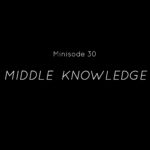What I have witnessed from recent Arminius and Arminian scholarship, at least among those who are self-identified as being Arminian, differs, I think, from what was known as Arminian fifty to hundred years ago, with very few exceptions.1
Among those few exceptions, however, include Foundations of Wesleyan-Arminian Theology by Mildred Bangs Wynkoop, published by Beacon Hill, 1967, as well as Man’s Faith and Freedom: The Theological Influence of Jacobus Arminius, edited by Gerald O. McCulloh, published originally by Abingdon, 1962, and Arminius: A Study in the Dutch Reformation by Carl O. Bangs, published originally by Abingdon, 1971.
In 1960, Westcott published Robert Lee Shank’s Life in the Son, promoting the doctrine of Apostasy, and in 1970, Bethany House published Shank’s Elect in the Son, promoting the doctrine of Conditional, Corporate Election. Of the latter, a professor at Southern Baptist Theological Seminary commented that Shank’s work is “thorough, objective, competent” and biblical, calling it “the definitive work on the difficult question of election” (from the back cover). In 1975, Bethany also published a series of articles in the book Grace Unlimited, edited by Dr. Clark H. Pinnock, and then in 1989, the same company published another series of articles in the book The Grace of God, the Will of Man, also edited by Pinnock. The editor, Pinnock, wrote one article in each book, while the remaining articles featured Arminian scholars such as Donald M. Lake, Jack W. Cottrell, I. Howard Marshall, Grant R. Osborne, Terry L. Miethe, William Lane Craig and Randall G. Basinger. Each author takes his theology very seriously, and seeks to honor God in glorifying Christ Jesus through the grace of the Holy Spirit.
In the 1990s, Arminian scholarship developed through men such as Thomas C. Oden’s The Transforming Power of Grace, published by Abingdon, to say nothing of his own Trinity-formulated Systematic Theology. In 1991, Baker published Calvinist scholar Richard A. Muller’s God, Creation, and Providence in the Thought of Jacob Arminius: Sources and Directions of Scholastic Protestantism in the Era of Early Orthodoxy. Muller confessed that the theology of Jacob Arminius “has been neglected both by his admirers and by his detractors” (269). The truth of that statement, coupled with the rise of Calvinism in the late twentieth to early twenty-first centuries, would give rise to interest in Arminius’s thought and theology, as well as defining more sharply what is to be meant by “Arminianism.”
John D. Wagner edited Arminian Puritan John Goodwin’s Redemption Redeemed: A Puritan Defense of Unlimited Atonement in 2001, published by Wipf & Stock. Herbert Boyd McGonigle wrote Sufficient Saving Grace: John Wesley’s Evangelical Arminianism and was published by Paternoster in 2001. While John and Charles Wesley have historically garnered much attention for their Wesleyan-Arminianism, attention was turned toward Arminius himself by Dr. F. Leroy Forlines’ The Quest for Truth: Answering Life’s Inescapable Questions, published by Randall House in 2001 (updated and edited by Dr. J. Matthew Pinson as Classical Arminianism: A Theology of Salvation, 2011), and Dr. Robert E. Picirilli’s Grace, Faith, Free Will: Contrasting Views of Salvation: Calvinism & Arminianism, also published by Randall House, 2002. Both Forlines (link) and Picirilli (link) have published commentaries on the book of Romans.
The Arminianism — or what was thought of as Arminianism — of the early twentieth century (almost a caricature of itself) has been quickly vanishing from the 1960s to the present. With the advent of Dr. Roger E. Olson’s Arminian Theology: Myths and Realities, published by IVP Academic, 2006, Arminius and Arminian theology was put in its proper, intellectual place in theological dialogue. Even though Calvinists sorely disagree with Olson’s Arminian theology, they are obliged to concede that both Arminius and Arminianism have been misrepresented at times, and that neither Arminius nor Arminian theology is Pelagian or even semi-Pelagian.
Recent scholarship has only improved in this decade, in my opinion, from F. Stuart Clarke’s The Ground of Election: Jacobus Arminius’ Doctrine of the Work and Person of Christ, published by Paternoster, 2006, to both of John D. Wagner’s edited books: Daniel D. Whedon’s Freedom of the Will: A Wesleyan Response to Jonathan Edwards, and Arminius Speaks: Essential Writings on Free Will, Predestination, and the Nature of God, both published by Wipf & Stock, 2009 and 2011 respectively. Publishers T&T Clark International have produced Dr. Brian J. Abasciano’s Paul’s Use of the Old Testament in Romans 9:1-9: An Intertextual and Theological Exegesis, 2005, and recently published Dr. Abasciano’s second series Paul’s Use of the Old Testament in Romans 9:10-18: An Intertextual and Theological Exegesis, 2011. By the time his third in the series is complete, they will consist of the most comprehensive study of Romans 9 in print.
There is also present Arminius scholarship active in Holland among Calvinist and non-Calvinist scholars. For example, Brill Publisher’s Series in Church History has produced Arminius on the Assurance of Salvation: The Context, Roots, and Shape of the Leiden Debate, 1603-1609, by Calvinist Dr. Keith D. Stanglin, 2007; Arminius, Arminianism, and Europe: Jacob Arminius, 1559/60-1609, edited by Th. Marius van Leeuwen, Keith D. Stanglin, and Marijke Tolsma, 2010; and most recently, The Missing Public Disputations of Jacobus Arminius, by Keith D. Stanglin, 2010. H.Y. Groenewegen, in 1909, referring to Arminius, commented, “His historical significance neither a sympathizer nor an opponent can misunderstand.”2 Dr. Stanglin, Assistant Professor of Historical Theology at Harding University, comments:
This was the claim of Remonstrant professor H.Y. Groenewegen, who, exactly one century ago [written in 2009], said this about Jacobus Arminius on the occasion of the third centennial of the death. Reflecting now, with another century behind us, we can repeat this sentiment only with great qualification, for historians, theologians, and ministers too often continue to misunderstand and underestimate Arminius’s significance.3
The by-gone era of C.I. Scofield, who was mistaken as an Arminian, and the sometimes accurate smear of overly-zealous-yet-cerebral-challenged Arminians has given way to an intellectual fervor among astute Arminians who maintain a fervent heart for theology, ecclesiology, worship, holiness, and the proclamation of the gospel to the nations, which glorifies God as Savior in Christ Jesus through the work and ministry and grace of the ever-present, ever-active Holy Spirit. In other words, this ain’t your grandpa’s Arminianism.
__________
1 What follows is merely a sampling of Arminian scholarship over the last fifty years. Many other titles could be mentioned, including but not limited to (and in no particular order): The Works of Arminius, The Truth of the Christian Religion by Hugo Grotius, edited by John Clarke; The Arminian Confession of 1621 by Simon Episcopius, edited by Mark A. Ellis; Understanding Assurance of Salvation by Robert E. Piciriili; Whosoever Will: A Biblical-Theological Critique of Five-Point Calvinism, edited by David L. Allen and Steve. W. Lemke (self-identified as “non-Calvinists,” not Arminians), Why I am not a Calvinist by Jerry L. Walls and Joseph R. Dongell, and The Other Side of Calvinism by Laurence M. Vance. Yet, for personal reasons, I choose not to promote The Dark Side of Calvinism by George Bryson, What Love is This? Calvinism’s Misrepresentation of God by Dave Hunt, Greek Grammar and Syntax Versus Calvinism by Malcolm L. Lavender, or A Cultish Side of Calvinism by Micah Coates. Also note the absence of any theological work by semi-Pelagian revivalist Charles G. Finney.
2 Taken from the chapter, “Arminius and Arminianism: An Overview of Current Research” by Keith D. Stanglin, in Arminius, Arminianism, and Europe: Jacob Arminius, 1559/60-1609, eds. Th. Marius van Leeuwen, Keith D. Stanglin, and Marijke Tolsma (Leiden: Brill, 2010), 3.
3 Ibid.






Leave a Reply